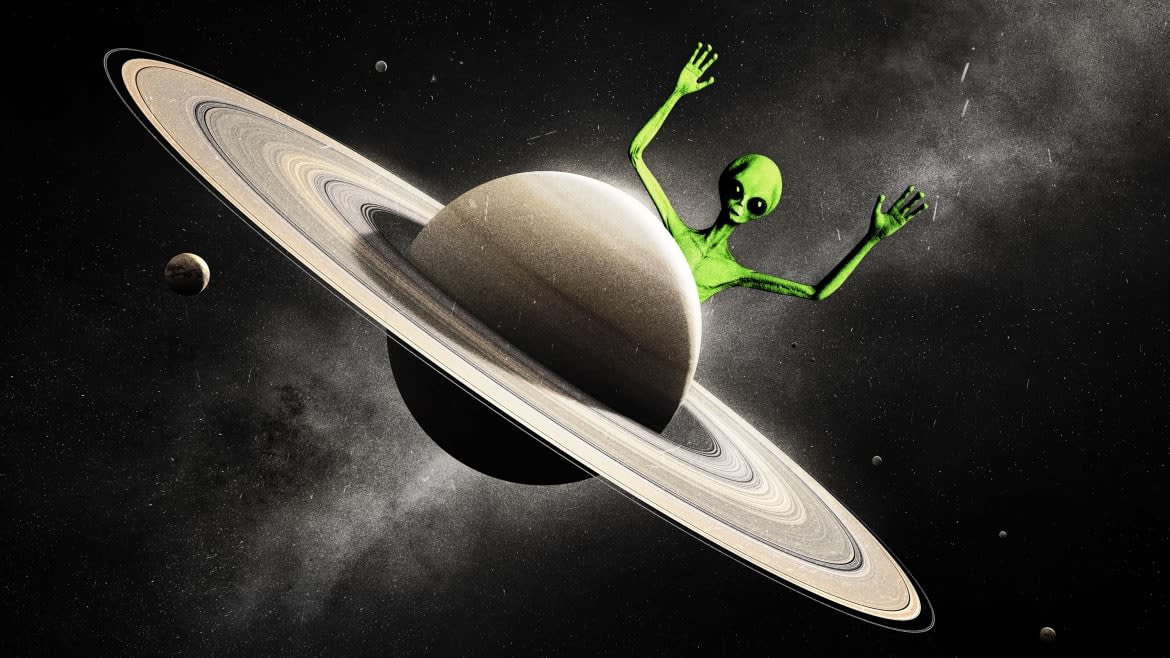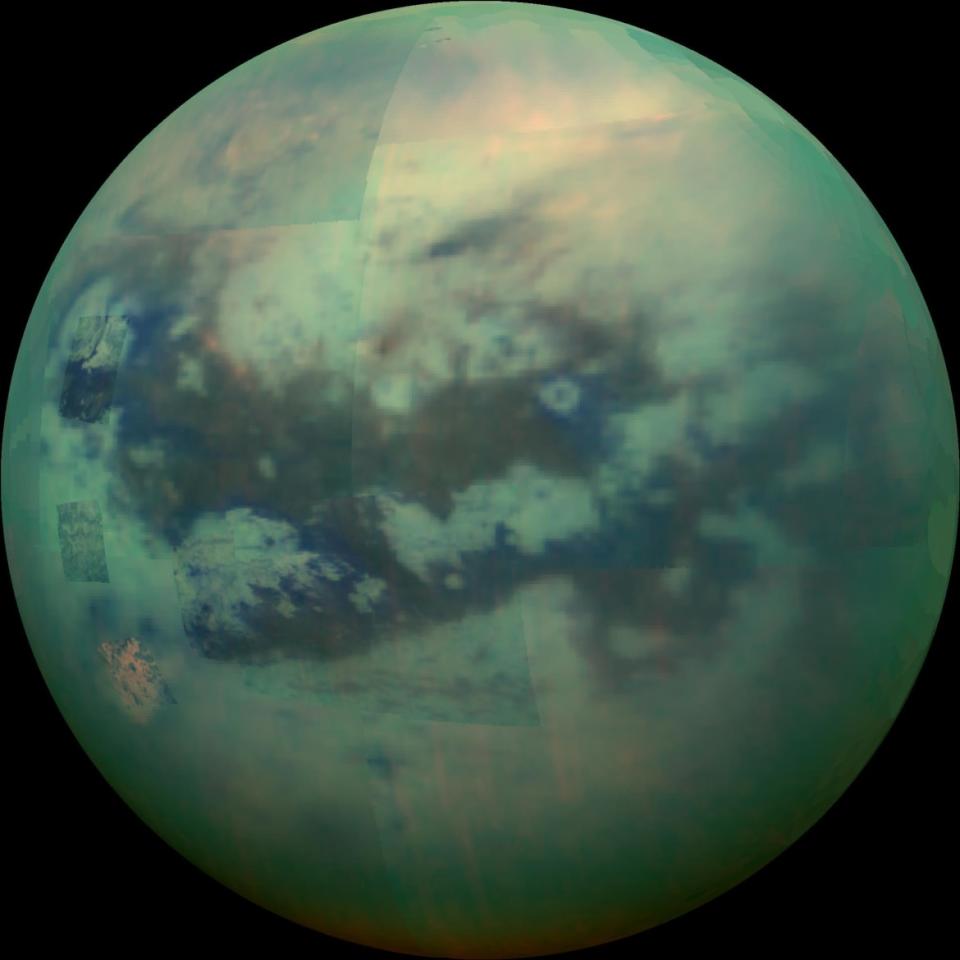Saturn’s Moon Titan May Be the ‘Bellwether’ for Alien Life

Saturn has 83 moons. But one of them, Titan, is special. That’s because it’s the only moon in the solar system with a substantial atmosphere. A cold one, to be sure, but an atmosphere nonetheless. On its surface, Titan’s got frigid rivers and lakes of methane. Below the surface, there’s ice. And below that, water. Lots of it.
Titan is big too—40 percent the size of Earth, in fact.
There might be even more to Titan than we already know. According to Avi Loeb, a Harvard physicist and a big proponent of an aggressive search for alien life, Titan not only could harbor strange forms of life in and around its methane rivers, it could also point us toward similar life on similar planetary bodies all over the universe.
“Titan would be a bellwether for life on cold planets and moons,” Loeb told The Daily Beast. He detailed his theory in a new, peer-reviewed paper that is slated for publication in Research Notes of the American Astronomical Society. The paper appeared online on Dec. 2.

Saturn’s moon Titan could be the bellwether for alien life across the universe.
The huge moon’s bitter coldness is key to Loeb’s argument. Spinning around Saturn roughly 900 million miles from the sun, Titan has an average temperature of nearly minus 300 degrees Fahrenheit (-185 C). That’s way too cold for Earth life—but it might not be for hardy, methane-loving microbes that could be the possible starting point for some very weird evolution.
Weird to us, that is. In fact, it might be pretty common by galactic standards.
There are lots of planets and moons in our solar system that have, or had, the potential to support life: Mars with its dried-up oceans, Venus and its nutrient-rich, noxious atmosphere, and Io, a moon of Jupiter with hundreds of active volcanoes and a lot of pent-up energy.
What’s especially interesting about Titan is that its coldness is typical of potentially billions of moons and planets all over the universe. If tough, cold-resistant forms of life can evolve there, they could also evolve on a whole lot of other, similar planets and moons.
Saturn May Have Gotten Its Rings by Murdering One of Its Moons
Taking a fresh look at survey data, Loeb concluded Titan’s temperature matches the level of warming that should result solely from the background radiation of the universe. In other words, if you pick one of the unlit “rogue” planets that’s drifting in the vast void between stars and take its temperature, you could expect that planet to be about as cold as Titan.
“It does not need to be close to a star,” Loeb told The Daily Beast. “The cosmic microwave background, left over from the Big Bang, would have kept it at [that] temperature.” Forms of life that are comfortable on Titan might also be comfortable on countless other moons, planets, and free-floating rogue planets—and even big asteroids.
As a bonus, many moons, planets, and other objects in space started stabilizing at an average temperature of minus 300 F starting really early in the long life of the universe. The Big Bang occurred around 13.8 billion years ago. Just 100 million years after that, there were probably a lot of planets and moons with the average temperature that Titan has now, Loeb said.

This composite image shows an infrared view of Saturn’s moon Titan from NASA’s Cassini spacecraft, acquired during the mission's “T-114” flyby on Nov. 13, 2015.
“If life exists on Titan, then it could have emerged in the universe 100 million years after the Big Bang,” Loeb explained. The first microbes didn’t appear on Earth until 3.7 billion years ago. So Titaneseque life would’ve had a 10-billion-year head start.
That long lead alone is a good reason to go looking for chilly lifeforms on chilly planets and moons. Assuming there’s life all over the universe—and more and more scientists are coming around to this possibility—Titanesque life could be the oldest form of life—and potentially the most common. “This is my main new point, which has to do with the question of when life started in the cosmos,” Loeb said.
Still, there are good reasons to be skeptical of Loeb’s “old and cold” profile of possible Titan life. For starters, not every astrobiologist or planetary scientist agrees that the background radiation of the universe would warm distant planets and moons to a constant temperature of 300 degrees below zero. “I don't know that that [radiation] is a reasonable source of heat,” Matthew Siegler, an astronomer with the Planetary Science Institute in Arizona, told The Daily Beast.

Methan clouds drifting over Titan.
Even if background radiation does heat planets and moons to the same temperature as Titan, it’s worth remembering just how cold 300 degrees below zero is—and how detrimental it could be to evolution. Extreme cold tends to slow chemical reactions, and there’s no evolution without sustained chemistry. “How slow is too slow for something to react faster than it is destroyed?” Siegler asked. “Does Titan have enough energy for life?”
No one knows for sure. But we might find out soon. NASA plans to launch a probe called Dragonfly toward Titan in 2027. It should arrive at the moon seven years later.
Even if Dragonfly finds conditions for, or even direct evidence of, microbial life on Titan, we shouldn’t rush to conclude that similar cold-loving life is present on countless ancient space rocks, David Grinspoon, an astrobiologist who’s also with the Planetary Science Institute, told The Daily Beast.
If there’s life, or the remains of life, on the Saturnian moon, it could be because Titan—despite its low temperature—is more similar to Earth than it is to the universe’s much older and colder planets and moons. “The best kind of world to find life is one with a young surface, vigorous geological activity, active meteorological cycles, interesting active chemistry and abundant phase changes,” Grinspoon said. “Like Earth. And like Titan.”
Got a tip? Send it to The Daily Beast here
Get the Daily Beast's biggest scoops and scandals delivered right to your inbox. Sign up now.
Stay informed and gain unlimited access to the Daily Beast's unmatched reporting. Subscribe now.

 Yahoo Movies
Yahoo Movies 
